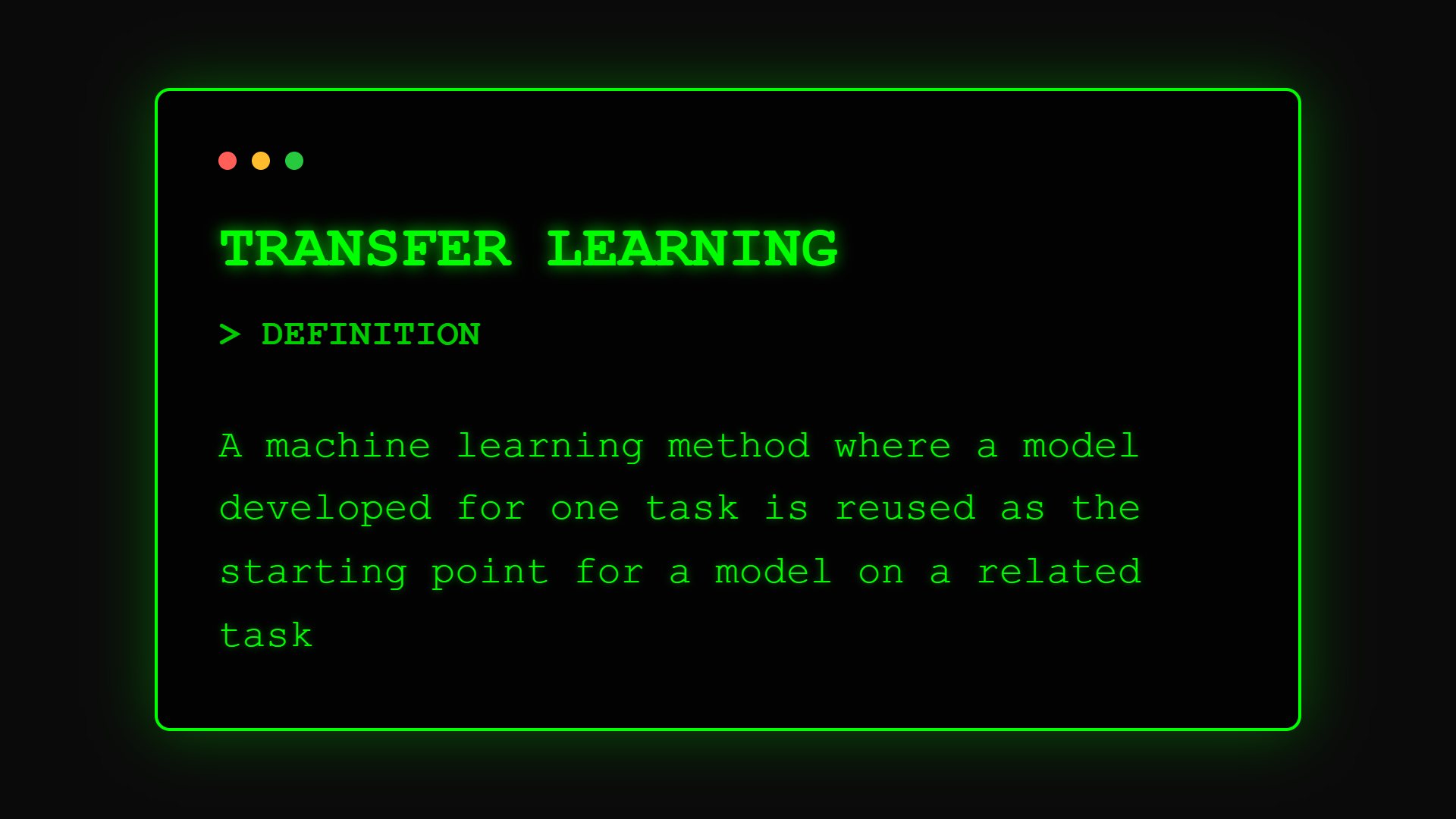AI Terms
What is Transfer Learning? When AI Remembers Its Lessons

Imagine if every new employee had to learn everything from scratch – no transferable skills, no prior experience. That's how traditional AI worked. Transfer learning changes this, letting AI apply knowledge from previous tasks to new challenges, dramatically reducing time and cost.
Technical Definition
Transfer learning is a machine learning technique where a model developed for one task is reused as the starting point for a related task. Instead of training from scratch, the model transfers knowledge gained from a data-rich source domain to improve learning in a data-scarce target domain.
According to Andrew Ng, Stanford professor and AI pioneer, "Transfer learning will be the next driver of ML commercial success after supervised learning." The technique leverages the fact that features learned for one task (like recognizing edges in images) often apply to related tasks.
Technically, transfer learning works by taking pre-trained neural network layers (typically trained on massive datasets) and adapting them for specific use cases through fine-tuning or feature extraction.
Business Perspective
For business leaders, transfer learning is like hiring an experienced professional instead of a fresh graduate – they bring valuable skills that transfer to your specific needs, getting productive faster with less training.
Think of it as AI with a resume. Just as an experienced marketing manager can quickly adapt to a new industry using their core skills, transfer learning lets AI models apply general knowledge to specific business problems.
In practical terms, this means you can deploy sophisticated AI capabilities without millions of training examples or months of development time. A model trained on general images can quickly learn to inspect your specific products.
Core Components
Transfer learning consists of these elements:
• Pre-trained Model: A foundation model trained on large, general datasets (like ImageNet for vision or GPT for language) that has learned fundamental patterns
• Feature Extraction: Lower layers of the network that capture general features (edges, shapes, grammar) that transfer across domains
• Task-Specific Layers: New layers added on top that learn the specific requirements of your business problem
• Fine-tuning Process: Carefully adjusting the pre-trained weights to optimize for your specific data while preserving general knowledge
• Domain Adaptation: Techniques to handle differences between the source domain (original training) and target domain (your use case)
How Transfer Learning Works
The process follows these steps:
Start with Pre-trained Model: Select a model already trained on a large, relevant dataset – like BERT for text or ResNet for images
Adapt Architecture: Modify the model's final layers to match your specific task, keeping the knowledge-rich early layers intact
Fine-tune on Your Data: Train the modified model on your smaller dataset, with most learning happening in the new layers while slightly adjusting pre-trained layers
This approach typically requires 10-100x less data than training from scratch and converges much faster.
Transfer Learning Strategies
Different approaches for different needs:
Strategy 1: Feature Extraction Best for: Very small datasets (100-1000 examples) Approach: Freeze pre-trained layers, train only new layers Example: Product defect detection with limited defect images
Strategy 2: Fine-tuning Best for: Moderate datasets (1000-10000 examples) Approach: Slowly adjust all layers with small learning rate Example: Medical image diagnosis for specific conditions
Strategy 3: Progressive Unfreezing Best for: Complex adaptations Approach: Gradually unfreeze and train layers over time Example: Sentiment analysis for industry-specific jargon
Strategy 4: Multi-task Learning Best for: Related simultaneous tasks Approach: Share base layers across multiple objectives Example: Customer service bot handling multiple query types
Business Impact
Real companies achieving real results:
Healthcare Example: Stanford researchers used transfer learning to diagnose skin cancer with dermatologist-level accuracy using only 130,000 images instead of millions, reducing development time from years to months.
Retail Example: Zalando applies transfer learning for fashion recommendation, adapting general image models to understand style preferences with 85% less training data than traditional approaches.
Manufacturing Example: BMW uses transfer learning for quality inspection, adapting general computer vision models to detect specific defects in painted surfaces, achieving 95% accuracy with just 500 training images per defect type.
When to Use Transfer Learning
Transfer learning excels when:
• Limited Data: You have hundreds or thousands of examples, not millions • Similar Domain: Your task relates to existing pre-trained models • Time Constraints: You need results in weeks, not months • Resource Limits: You lack massive computational infrastructure • Proven Architectures: Similar problems have been solved before
Less suitable when:
• Unique Domain: Your data is completely unlike existing datasets • Extreme Precision: You need absolute best performance • Regulatory Requirements: You must fully understand/control the model
Implementation Path
Ready to leverage pre-trained intelligence?
- Understand the foundation with Deep Learning
- Explore Fine-tuning techniques
- Learn about Foundation Models
- Read our Transfer Learning Playbook
FAQ Section
Frequently Asked Questions about Transfer Learning
Part of the [AI Terms Collection]. Last updated: 2025-01-11